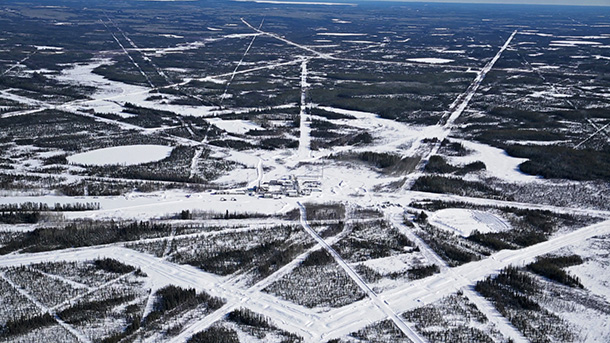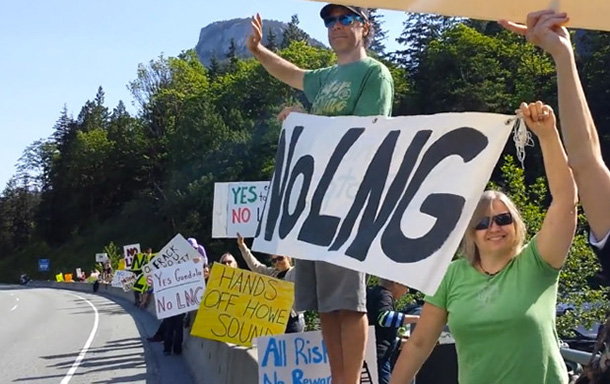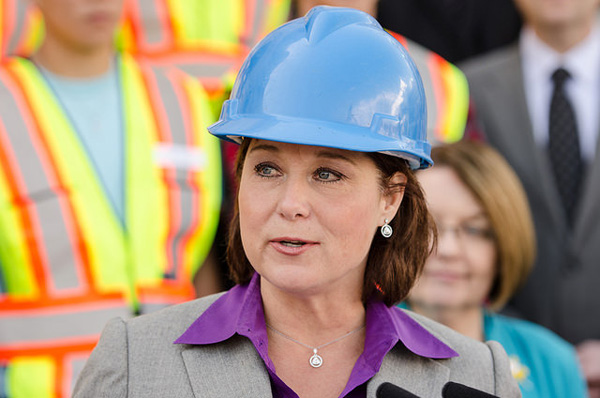The more Christy Clark defends her dream of an LNG industry, the more she turns cold gas into hot air. The B.C. premier's interview with Andrew MacLeod published last week in The Tyee is a case in point. As MacLeod pressed with many LNG-related questions, Clark resorted to three big, bloated fibs.
Fib #1: LNG is 'clean'
While making our documentary Fractured Land about fracking in B.C., co-director Fiona Rayher and I journeyed to Cornell University to interview Dr. Robert Howarth. He is a global expert on the climate impacts of fracking.
We told him our premier has affixed the label "Cleanest Fossil Fuel on the Planet" to B.C. LNG (derived almost entirely from a massive increase in fracking in the province's northeast).
Howarth chuckled and said: "Your premier has her facts wrong!"
It is true that "natural" gas, an old euphemism for methane, burns cleaner than coal when you turn on your stove or fireplace at the end of the line. But when it escapes into the atmosphere before it's burned, it's some 80 times more potent as a greenhouse gas than CO2 over a 20-year period.
What Dr. Howarth's research shows is that far more methane escapes while fracking, processing and piping it than we previously thought (3.5-7 per cent of it). And that makes fracked gas dirtier than coal. Especially when you later turn it into LNG, which requires burning gas to power the energy-intensive cooling process, then burning even more to get the tanker to Japan or China. In fact, with just a handful of plants, we could double the entire province's carbon footprint. (Wouldn't using hydro power from the Site C dam be cleaner, you ask? See sidebar.)
There are also the billions of litres of freshwater contaminated each year for fracking in northeast B.C., plus the earthquakes stimulated by the pumping of toxic water deep underground. Add to that a whole lot of roads and well pads carved out of northern boreal forest, and you've got some sense of where this "clean" LNG really comes from.
Knowing this, it's high time we replace the term LNG with LFG: Liquefied Fracked Gas. Far from being "natural" or the "cleanest fossil fuel," it's more fair to call it "the dirtiest."
Fib #2: The business case for LNG is solid
The Asian LNG market is in freefall. Prices that peaked at $18 per million British thermal units (MMBtu) just a few years ago are the reason we started down this path. Now they have plummeted to the $7 range today, with leading analysts forecasting $4-5 per MMBtu in 2016-17. Just to break even on gas fracked in northeast B.C., piped to the coast, compressed and loaded onto tankers bound for Asia, you need to fetch about $12 per MMBtu. It doesn't take a PhD in economics to figure out why. As The Tyee's MacLeod put to our premier, expert consultants like IHS Inc. predict "19 out of 20 planned gas export projects in the world won't be needed by 2025."
"The biggest story is the increase in LNG export capacity," explained Mike Fulwood, principal for global gas at Nexant Inc., to Bloomberg recently. With new plants from Australia and the U.S. coming online in 2016, coupled with decreased demand in China and Japan, prices show no sign of recovering for years to come.
Energy and Mines Minister Rich Coleman has spoken often of B.C. needing to "win the LNG race." Well, it's over and we lost.
Premier Clark can crow all she wants about $20 billion of foreign investment thus far -- that's almost all upstream, in the acquisition and development of fracking plays. Not one of the 21 companies or conglomerates proposing an LNG terminal downstream has reached a final investment decision to spend the more than $10 billion required for plant construction. Nor are they likely to at this point.
Besides viable prices, another important component of good business is the quality and integrity of your partners. Here, our premier clearly lacks judgment. In the Tyee interview, she laughs off the $700 million corruption scandal in which Najib Razak, the prime minister of Malaysia and ultimate boss of state-owned Petronas, is embroiled. "Makes me feel like I went into business in the wrong country," Clark quips. "It's crazy. But you know, it's just a different way of doing business, I guess..."
She also seems unaware or unconcerned with the company's shoddy safety record -- recently exposed in the Vancouver Sun.
Meanwhile, Clark has embraced Woodfibre LNG -- the plant proposed for Howe Sound, near Squamish -- even though its Indonesian owner is Sukanto Tanoto, whose companies have been accused of tax fraud, environmental devastation and human rights abuses in Southeast Asia.
The way these foreign players do business is also at the root of another of Christy Clark's economic fibs. She insists she can still fulfill her election promise to create an LNG-fueled $100 billion "Prosperity Fund" and tens of thousands of jobs. The reason we will never see those kind of numbers, even if a few plants wind up materializing, is that Clark and Coleman have already given away the farm.

Under pressure from the likes of Petronas to cut the public's share of the LNG bounty amid diminishing profit margins, we've seen our export tax rate cut to virtually nothing. I was in the room when Shamsul Abbas, then-CEO of Petronas, wagged a finger at British Columbians, threatening to pull up stakes if we didn't slash public benefits and cut environmental "red tape."
Sure enough, the province soon rubber-stamped Petronas's project, even though the federal government remains concerned about impacts on salmon habitat and has yet to rule. Meanwhile, the deal dropped export taxes from seven per cent to 1.5 per cent. Even that came with a loophole big enough to drive an LNG tanker through. Companies can deduct tens of billions of dollars in plant construction costs from what would be already piddly export taxes.
After shackling her whole political future to this one idea, the only way Premier Clark can see fit to keep Petronas and co. on the line is by giving away everything she promised to the people of B.C. Talk about a Pyrrhic victory.
Fib #3: First Nations and communities broadly support LNG
Premier Clark maintains, "We've got pretty broad agreement from First Nations and communities along the way [for LNG]." The Tsawwassen First Nation's recent rejection of an LNG plant on their reserve is just the latest example of why that's simply untrue.
I recently toured our fracking documentary Fractured Land across the northwestern part of the province. The film drew sizeable crowds and lively discussion in many of the communities where the LNG pipelines and plants are planned. Such places included Hazelton, Smithers, Terrace and Kitimat. Also Prince Rupert, where I went to visit the Lax Kw'alaams hereditary and grassroots leaders battling Petronas's plans for Lelu Island. Their people voted overwhelmingly against one of the most lucrative agreements ever offered to a First Nation over a resource project -- $1.15 billion in economic benefits -- because of concerns about the project's impact on wild salmon.
At Madii Lii Camp, a few hundred kilometres up the Skeena River, Gitxsan hereditary chiefs have positioned themselves in the path of Petronas's proposed pipeline. They're also going to court to battle the pipeline -- one of four First Nations-led cases challenging various aspects of Petronas's plans.
Further south, on the Morice River, members of the Unist'ot'en Clan of the Wet'suwet'en Nation maintain a multi-year occupation of another pipeline corridor –- this one bound for Kitimat. Treaty 8 First Nations are also becoming more standoffish toward fracking in their territory. And they are dead set against the Site C dam, which they continue to battle in the courts.

It's not just First Nations who are increasingly opposed to LNG and fracking. Communities and their municipal governments up and down Howe Sound and the Sunshine Coast are rejecting the proposed Woodfibre plant. Up north, the residents of the Kispiox Valley -- many of them non-native doctors, nurses, farmers, loggers, guide outfitters and business owners -- have also banded together in defiance of Petronas's proposed pipeline.
Opportunity costs
In the end, perhaps the most dangerous aspect of Christy Clark's LNG pipedream is the distraction it has become from other economic opportunities and important social priorities. Premier Clark assures us her government has a diverse economic vision -- yet everything seems somehow to come back to LNG and Site C. We can't even tackle child poverty, she says, unless we see economic growth first -- presumably from these initiatives.
While our leaders remain fixated on LNG, we're missing the real energy revolution, green energy, which has created eight million new jobs over the last decade in places like Germany, the U.S., China, Brazil and Korea.
Take note of that list: They're the world's biggest economic powerhouses and they appear to have something we sorely lack here in B.C.: real economic vision. No lie.
Please note our comment threads will be closed Dec. 21 to Jan. 3 to give our moderators a well-deserved break. Happy holidays, readers. ![]()
Read more: Energy, Local Economy, BC Politics















